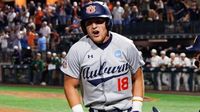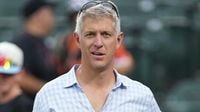The Baltimore Orioles’ 2025 MLB Draft haul has stirred up a buzz across the baseball world, and for good reason. With four picks among the first 37 selections, the Orioles front office, led by Mike Elias, strategically stocked their farm system with a blend of high-upside position players and promising pitchers. Yet, despite the overall excitement, one glaring gap remains: the absence of an impactful ace pitcher in the early rounds.
When the Orioles selected Ike Irish, a dynamic catcher/outfielder from Auburn, at No. 19 overall, it marked a surprising yet bold statement. Irish, a 6-foot-2, 201-pound left-handed hitter, had a standout junior season, slashing .364/.469/.710 with 19 home runs and 58 RBIs over 55 games. His offensive prowess was further highlighted by his ranking third in batting average, fourth in slugging percentage, and sixth in OPS in the Southeastern Conference. Notably, he blasted a 103 mph, 408-foot home run during the Super Regionals, showcasing his raw power.
However, Irish’s journey wasn’t without adversity. An injury in March 2025 fractured his right scapula after being hit by a pitch, forcing a positional shift to right field. Auburn coach Butch Thompson praised Irish’s adaptability and leadership, stating on Glenn Clark Radio, "Ike came here ready to hit, and he leaves here … being able to catch, being able to play in the outfield. He became our captain and leader of the program in his third year. To see where he started as a DH to becoming a well-rounded player and leader, he left a good legacy here." Thompson also emphasized Irish’s competitive at-bats, calling him "the most competitive at-bat that I have seen in my coaching career." He added, "I don’t think he gave an at-bat away. Every pitch that crosses home plate has been personal for him for three years, and that’s one of his separators." This resilience and hitting ability suggest Irish could have a long major-league career, whether behind the plate or patrolling the outfield.
Just 11 picks later at No. 30, the Orioles doubled down on catching by selecting Caden Bodine from Coastal Carolina University. Bodine’s 2025 stats underline his value: a .318/.454/.915 slash line, 18 doubles, five home runs, and an impressive walk-to-strikeout ratio of nearly 2:1. Defensively, Bodine boasts exceptional framing skills and a 39% caught-stealing rate, earning him a Division I Gold Glove award. Yet, questions linger about his athleticism, as evidenced by his limited stolen bases. With Adley Rutschman, Baltimore’s current starting catcher, struggling through a career-low .227 batting average this season, the addition of two promising catchers has sparked speculation about Rutschman’s future with the club. Meanwhile, top prospect Samuel Basallo, also a catcher, continues to impress in Triple-A, posting a .302 batting average with a .420 on-base percentage and 10 homers in June alone. This glut of catching talent creates an intriguing—and somewhat uncertain—logjam that could lead to positional shifts or trades down the line.
Adding to the offensive firepower, the Orioles selected Arkansas shortstop Wehiwa Aloy at No. 31. Aloy, the reigning Golden Spikes Award winner, rebounded from a down 2024 season to slash .350/.434/1.107 with 21 home runs and 68 RBIs in 2025. His defensive improvement was notable, committing just five errors in 65 games. With his blend of power and gap hitting, Aloy has the potential to become Baltimore’s premier infield prospect, possibly bumping current star Gunnar Henderson to third base. Aloy’s presence adds much-needed depth and dynamism to a farm system that has slipped from first to 22nd in prospect rankings over the past two years.
The Orioles continued their offensive draft spree by selecting high school outfielder Slater de Brun at No. 37. At 5-foot-10, de Brun has drawn comparisons to Arizona Diamondbacks’ Corbin Carroll for his speed and fielding prowess. His bat speed and exit velocity have improved markedly since 2023, signaling a promising future. De Brun’s ability to cover center field could place him in direct competition with Enrique Bradfield Jr., another top outfield prospect in Baltimore’s system.
Despite the offensive haul, Baltimore’s pitching needs remain pressing. The Orioles did not select a pitcher until the second round, when they picked Michigan State’s towering left-hander Joseph Dzierwa at No. 58. Standing 6-foot-7, Dzierwa impressed with an 11-3 record, 1.42 ERA, and 137 strikeouts over 118.2 innings in 2025, including four complete game shutouts. His four-pitch arsenal, featuring a highly graded changeup and fastball, along with developing curveball and slider, suggests a high ceiling. Dzierwa’s stamina and control have steadily improved since 2023, making him a potential steal for the Orioles if he continues to refine his breaking pitches.
Following Dzierwa, Baltimore selected right-hander JT Quinn from Georgia with the 69th pick in the competitive balance round B. Quinn, a 6-foot-6 pitcher, posted a 2.75 ERA with 49 strikeouts in 36 innings, although his elevated home run and walk rates raise concerns. While his fastball can reach 98 mph and he showed promise with a slider in the Cape Cod League, Quinn’s inconsistent location and lack of a reliable third pitch limit his upside. He is more likely to settle into a middle-of-the-rotation role rather than become an ace.
Rounding out their early pitching selections, the Orioles added USC lefty Caden Hunter in the sixth round, further bolstering their pitching depth. However, the absence of a clear ace among their early picks means Baltimore may need to explore trades, potentially leveraging their wealth of position player prospects to acquire a frontline starter.
MLB Pipeline senior writer Jim Callis recently ranked the Orioles No. 1 for "hoarding talent" in the 2025 MLB Draft, a testament to their successful accumulation of high-ceiling prospects. Baltimore outpaced organizations like the Pittsburgh Pirates, Tampa Bay Rays, and Boston Red Sox, securing six players from MLB Pipeline's Top 100 board. This draft class builds on the foundation laid by recent stars like Gunnar Henderson, Grayson Rodriguez, Jackson Holliday, and Samuel Basallo, who have all contributed to revitalizing the Orioles’ farm system.
Yet, the draft also raises intriguing questions about the Orioles’ future roster construction, particularly behind the plate. With Irish and Bodine joining Basallo in the catching ranks, and Rutschman’s struggles at the major league level, Baltimore faces a fascinating conundrum. Will Irish and Bodine remain behind the plate, or will positional shifts—like Irish’s move to the outfield at Auburn—become permanent to maximize their offensive potential? The crowded outfield prospect pool, including Enrique Bradfield Jr. and Dylan Beavers, adds another layer of complexity.
For now, the Orioles have taken a calculated gamble, focusing on high-upside bats to complement their existing core, while adding promising arms deeper in the draft. As Elias and his front office continue to shape the franchise’s future, the 2025 draft class could prove pivotal in Baltimore's quest to return to postseason contention. The team’s ability to develop these prospects and potentially package some for pitching help will be key to addressing their most glaring needs.
In the ever-evolving landscape of Major League Baseball, the Orioles’ 2025 draft haul represents a fascinating blend of promise and challenge. Fans can take heart in the talent amassed, but the coming years will reveal whether Baltimore’s strategy pays off, especially on the mound. For now, the Orioles have plenty of reasons to be optimistic, even as the work to build a championship contender continues.



